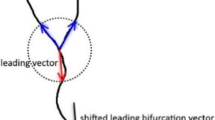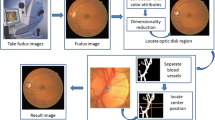Abstract
Precise detection of the optic disk (OD) is an important task in the diagnosis of diabetic retinopathy. To manage the massive diabetic population, there is a significant demand for efficient and remote retinal imaging techniques. In this regard, the use of handheld mobile cameras attached to a smartphone is a promising approach. However, smartphone retinal images are often of low quality, compared to those obtained on standard equipment. They also have a narrow field of view and an incomplete/unbalanced vessel structure. Hence, we propose a new, fully automatic hybrid method for OD localization (HLM). It is designed for and verified on mobile camera/smartphone retinal images. The HLM analyzes the vessel structure and finds the OD locations by using the exclusion method when an image has a complete vessel system, and a newly proposed line detection method, otherwise. For OD segmentation, an active contour model followed by the circle fitting approach is integrated into the HLM. The proposed method was tested on three mobile camera datasets and four datasets obtained by standard equipment. For mobile camera datasets, the HLM achieves an average accuracy of 98% for OD localization. The segmentation routine obtains an average precision of 92.64% and an average recall of 82.38%. Testing against the recent state-of-the-art methods on the standard datasets shows comparable performance.
Graphical abstract
The proposed framework for OD localization and segmentation designed for and verified on mobile camera retinal datasets and standard datasets. (EM - "Exclusion Method", LDM - "Line Detection Method", OD - "Optic Disk" and PPV - "Positive Predictive Value")














Similar content being viewed by others
References
About Diabetes (accessed 4 January 2020) International Diabetes Federation (IDF), Diabetes Atlas 9th Edition
Kim TN, Myers F, Reber C, Loury PJ (2018) A smartphone-based tool for rapid, portable, and automated wide-field retinal imaging. Transl Vis Sci Technol. https://doi.org/10.1167/tvst.7.5.21
Besenczi R, Tóth J, Hajdu A (2016) A review on automatic analysis techniques for color fundus photographs. Comput Struct Biotechnol J 14:371–384
Prasanna P, Jain S, Bhagat N, Madabhushi A (2013) Decision support system for detection of diabetic retinopathy using smartphones. 7th International Conference on Pervasive Computing Technologies for Healthcare and Workshops. pp 176–179
Myers JS, Fudemberg SJ, Lee D (2018) Evolution of optic nerve photography for glaucoma screening: a review. Clin Experiment Ophthalmol 46:169–176
Akil M and Elloumi Y (2019) Detection of retinal abnormalities using smartphone-captured fundus images: a survey. Real-Time Image Processing and Deep Learning, HAL-02121855
Hoover A, Goldbaum M (2003) Locating the optic nerve in a retinal image using the fuzzy convergence of the blood vessels. IEEE Trans Med Imaging 22:951–958
Cekic S, Stankovic-Babic G, Visnjic Z, Jovanovic I (2010) Optic disc abnormalities – diagnosis, evolution and influence on visual acuity. Bosn J Basic Med Sci 10:125–132
Gamm DM, Albert DM (2016) Blind spot. Encyclopedia Britannica. https://www.britannica.com/science/blind-spot. Accessed 28 Nov 2016
Thakur N, Juneja M (2018) Survey on segmentation and classification approaches of optic cup and optic disc for diagnosis of glaucoma. Biomed Signal Process Control 42:162–189
Almazroa A, Burman R, Raahemifar K, Lakshminarayanan V (2015) Optic disc and optic cup segmentation methodologies for glaucoma image detection: a survey. J Ophthalmol. https://doi.org/10.1155/2015/180972
Allam A, Youssif A, Ghalwash A (2015) Automatic segmentation of optic disc in eye fundus images: a survey. Electron Lett Comput Vis Image Anal 14:1–20
Veena HN, Muruganandham A, Kumaran TS (2020) A review on the optic disc and optic cup segmentation and classification approaches over retinal fundus images for detection of glaucoma. Springer Nat Appl Sci. https://doi.org/10.1007/s42452-020-03221-z
Abdullah F et al (2021) A review in glaucoma disease detection using computerized techniques. IEEE Access 9:37311–37333
Noor NM, Khalid NEA, Ariff NM (2013) Optic cup and disc color channel multi-thresholding segmentation. IEEE International Conference on Control System, Computing and Engineering. pp 530–534
Ruennark T et al (2019) Alternative deflation-inflation gradient vector flow snakes for prescreening glaucoma in mobile phone retinal images. In Proceedings of the 23rd International Computer Science and Engineering Conference (ICSEC)
Siddalingaswamy PC, Gopalakrishna PK (2010) Automatic localization and boundary detection of optic disc using implicit active contours. International Journal of Computer Applications 0975–8887, Vol. 1, No. 7
Esmaeili M, Rabbani H, Dehnavi AM (2012) Automatic optic disk boundary extraction by the use of curvelet transform and deformable variational level set model. Pattern Recogn 45(2012):2382–2842
Wang Y, Yu X, Chi J, Wu C (2019) Automatic segmentation of optic disc and cup in retinal fundus images using improved two-layer level set method. Math Probl Eng 2019:4836296
Naqvi SS et al (2019) Automatic optic disk detection and segmentation by variational active contour estimation in retinal fundus image. SIViP 13:1191–1198
Gao Y et al (2019) Accurate and efficient segmentation of optic disc and optic cup in retinal images integrating multi-view information. IEEE Access 7:148183–148197
Yin F et al. (2012) Automated segmentation of optic disc and optic cup in fundus images for glaucoma diagnosis. 25th IEEE International Symposium on Computer-Based Medical Systems, https://doi.org/10.1109/cbms.2012.6266344
Rehman ZU et al (2019) Multi-parametric optic disc segmentation using superpixel based feature classification. Expert Syst Appl 120(2019):461–473
Gui B, Shuai R, Chen P (2018) Optic disc localization algorithm based on improved corner detection. Proc Comput Sci 131:311–319
Rodrigues LC, Marengoni M (2017) Segmentation of optic disc and blood vessels in retinal images using wavelets, mathematical morphology and Hessian-based multi-scale filtering. Biomed Signal Process Control 36:39–49
Sopharak A, Nwe KT, Moe YA, Dailey MN (2008) Automatic exudate detection with a naive Bayes classifier. International Conference on Embedded Systems and Intelligent Technology. pp 139–142
Rahebi J, Hardalaç F (2016) A new approach to optic disc detection in human retinal images using the firefly algorithm. Med Biol Eng Compu 54:453–461
Abed S, Al-Roomi SA, Al-Shayeji M (2016) Effective optic disc detection method based on swarm intelligence techniques and novel pre-processing steps. Appl Soft Comput 49:146–163
Lu S (2011) Accurate and efficient optic disc detection and segmentation by a circular transformation. IEEE Trans Med Imaging 30:2126–2133
Youssif AR, Ghalwash AZ, Ghoneim AR (2008) Optic disc detection from normalized digital fundus images by means of a vessels’ direction matched filter. IEEE Trans Med Imaging 27:11–18
Mahfouz AE, Fahmy AS (2010) Fast localization of the optic disc using projection of image features. IEEE Trans Image Process 19(12):3285–3289
Lalonde M, Beaulieu M, Gagnon L (2001) Fast and robust optic disc detection using pyramidal decomposition and Hausdorff-based template matching. IEEE Trans Med Imaging 20:1193–1200
Abdullah AS, Rahebi J, Ozak YE, Aljanabi M (2020) A new and effective method for human retina optic disc segmentation with fuzzy clustering method based on active contour model. Med Biol Eng Compu 58:25–37
Thakur N, Juneja M (2019) Optic disc and optic cup segmentation from retinal images using hybrid approach. Expert Syst Appl 127:308–322
Khan TM, Mehmood M, Naqvi SS, Butt MFU (2020) A region growing and local adaptive thresholding-based optic disc detection. PLoS ONE 15(1):e0227566. https://doi.org/10.1371/journal.pone.0227566
Muangnak N, Aimmanee P, Makhanov S, Uyyanonvara B (2015) Vessel transform for automatic optic disk detection in retinal images. IET Image Proc 9:743–750
Duanggate C, Uyyanonvara B, Makhanov S, Barman S (2011) Parameter-free optic disc detection. Comput Med Imaging Graph 35:51–63
Muangnak N, Aimmanee P, Makhanov S (2018) Automatic optic disk detection in retinal images using hybrid vessel phase portrait analysis. Med Biol Eng Compu 56:583–598
Besenczi R, Szitha K, Harangi B, Csutak A (2015) Automatic optic disc and optic cup detection in retinal images acquired by mobile phone. Ninth International Symposium on Image and Signal Processing and Analysis (ISPA) pp. 193–198. https://doi.org/10.1109/ISPA.2015.7306057
Otsu N (1979) A threshold selection method from gray-level histograms. IEEE Trans Syst Man Cybern 9:62–66
Khaing TT, Aimmanee P (2017) Optic disk localization using exclusion method. Twelfth International Conference on Knowledge, Information and Creativity Support Systems (KICSS2017) ISBN-13: 978–4815008147. pp 126–131
Duan D, Xie M, Mo Q, Han Z (2010) An improved Hough transform for line detection. International Conference on Computer Application and System Modeling. pp 354–357. https://doi.org/10.1109/ICCASM.2010.5620827
Duda RO, Hart PE (1972) Use of the Hough transformation to detect lines and curves in picture. Commun ACM 15:11–15
Hall M, Frank E, Holmes G, Pfahringer B (2009) The WEKA data mining software: an update. SIGKDD Explor 11:10–18
Chan TF, Vese LA (2001) Active contours without edges. IEEE Trans Image Process 10:266–277
Kimme C, Ballard D, Sklansky J (1975) Finding circles by an array of accumulators. Commun ACM 18:120–122
Thammasat Eye Center, Thammast University Hospital (Thailand) (2019) Mobile Camera Retinal Collections. http://www.tec.in.th/. Accessed 9 July 2019
Volk (2017) Volk iNview retinal camera. In: Volk Optical Inc. https://volk.com/index.php/volk-products/ophthalmic-cameras/volk-inview/. Accessed 1 Sept 2017
Retinopathy of Prematurity (2020) EyeWiki https://eyewiki.aao.org/Retinopathy_of_Prematurity
Hoover A, Goldbaum M (1975) The STructure Analysis of the REtina (STARE) project. http://www.ces.clemson.edu/~ahoover/stare/. Accessed 1 Sept 2016
Kauppi T, Kalesnykiene V, Kamarainenetal J (2006) DIARETDB0: evaluation database and methodology for diabetic retinopathy algorithms. Machine Vision and Pattern Recognition Research Group, Lappeenranta University of Technology, Lappeenranta, Finland
Kauppi T, Kalesnykiene V, Kamarainenetal J (2007) The DIARETDB1diabetic retinopathy database and evaluation protocol. British Machine Vision Conference (BMVC’07), Warwick, UK. pp.1–10
Acknowledgements
We would like to acknowledge Thammasat Eye Center (TEC) for providing the mobile camera datasets and for conductive discussions regarding the clinical experiments.
Funding
This work received financial support from the Thai Government Research Fund (contract numbers 33/2560 and 24/2561), the National Research Council of Thailand (NRCT) (grant number NRCT5-RSA63010-05), the JSPS Core-to-Core Program (grant number JPJSCCA20170004), and the Center of Excellence in Biomedical Engineering of Thammasat University.
Author information
Authors and Affiliations
Corresponding author
Additional information
Publisher's note
Springer Nature remains neutral with regard to jurisdictional claims in published maps and institutional affiliations.
Rights and permissions
About this article
Cite this article
Khaing, T.T., Aimmanee, P., Makhanov, S. et al. Vessel-based hybrid optic disk segmentation applied to mobile phone camera retinal images. Med Biol Eng Comput 60, 421–437 (2022). https://doi.org/10.1007/s11517-021-02484-x
Received:
Accepted:
Published:
Issue Date:
DOI: https://doi.org/10.1007/s11517-021-02484-x




